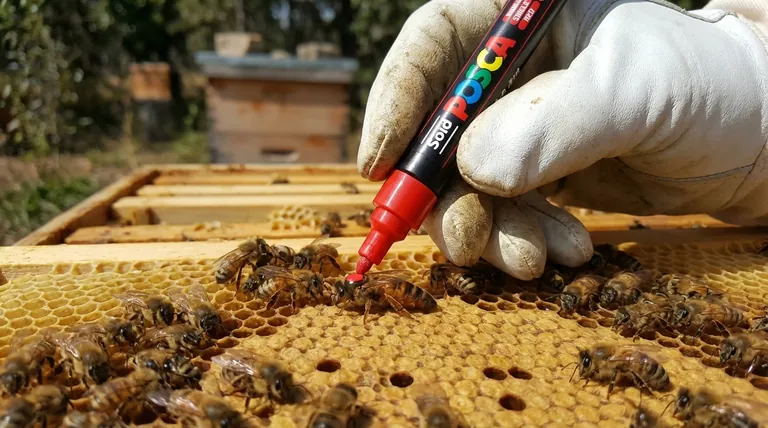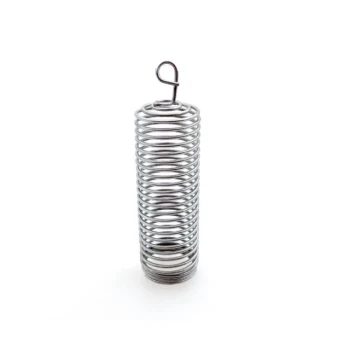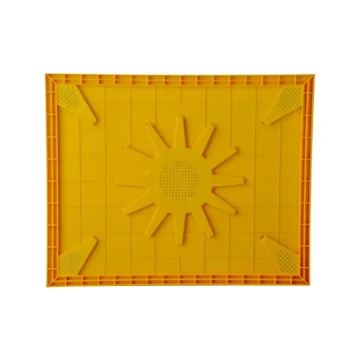The recommended technique for marking a queen bee is to gently touch a saturated, non-toxic marking pen to the top center of her back, an area called the thorax. The entire process must be done with the absolute minimal amount of pressure necessary to transfer the ink. A successful application is so light and gentle that the queen barely notices it.
The core purpose of marking a queen is to improve hive management by making her easily identifiable. The success of this task depends entirely on one principle: gentleness. A proper marking is safe for the queen and hive, but only if performed with a slow hand and minimal pressure.

Why Marking is a Standard Practice
Marking your queen bee is a fundamental skill that provides immediate, valuable information about the state of your colony. It transforms hive inspections from a search party into a targeted assessment.
Instant Identification
A small, colored dot on the queen's thorax makes her stand out among thousands of other bees. This allows a beekeeper to locate her quickly during an inspection, saving time and reducing disruption to the hive.
Assessing Queen and Hive Health
Quickly finding the queen allows you to confirm the hive is queenright (has a healthy, laying queen). You can more easily observe her condition and her laying patterns, which are key indicators of the colony's overall health and productivity.
The Core Technique Explained
The physical act of marking is simple, but it requires a steady hand and a calm approach. The queen's well-being is the top priority.
The Correct Location: The Thorax
The mark should always be applied to the top center of the thorax. This is the hard, middle section of her body between the head and abdomen. Applying it here ensures the mark is visible and cannot be easily groomed off by other bees.
The Principle of Minimal Pressure
The most critical element is using as little pressure as possible. If the marker tip is properly saturated with ink, simply touching it to her back should be sufficient to leave a clear dot. Pushing down can injure or stress her.
A Gentle and Slow Application
Your movements should be deliberate and slow. A quick, jerky motion can alarm the queen. The goal is to apply the mark so gently that she doesn't react, ensuring a stress-free experience for her and the colony.
Understanding the Impact on the Hive
When performed correctly, marking a queen has no negative consequences for her or the colony. It is a safe and universally accepted beekeeping practice.
Safety for the Queen
A proper marking is completely safe. It does not inhibit her movement, shorten her lifespan, or affect her ability to lay eggs.
Acceptance by the Colony
The other bees in the hive do not react negatively to a marked queen. The mark does not interfere with her pheromones, mating flights, or any other aspect of daily hive life. The colony's behavior remains unchanged.
Applying This to Your Hive
Your approach to marking should be guided by the dual goals of effective identification and the queen's absolute safety.
- If your primary focus is safety: Prioritize using the absolute minimum pressure necessary; a gentle touch is all that is required.
- If your primary focus is accuracy: Always aim for the hard, central part of the thorax to ensure the mark is durable and visible.
- If your primary focus is hive stability: Work slowly and calmly to ensure the queen is not alarmed, which prevents any disruption to the colony.
A successful marking empowers you to manage your hive more effectively while prioritizing the well-being of your queen.
Summary Table:
| Key Aspect | Description |
|---|---|
| Technique | Gently touch a saturated, non-toxic marking pen to the thorax. |
| Pressure | Use the absolute minimal pressure necessary to transfer ink. |
| Goal | Make the queen easily identifiable without causing stress or harm. |
| Benefit | Saves time during inspections and confirms hive is queenright. |
Ready to improve your hive management with professional beekeeping supplies?
As a beekeeper, the well-being of your queen and the stability of your colony are paramount. HONESTBEE understands this. We supply commercial apiaries and beekeeping equipment distributors with the high-quality, reliable tools needed for precise and gentle hive management, including safe marking kits.
Let us equip you for success. Contact our expert team today to discuss your wholesale needs and discover how our supplies can help you maintain healthier, more productive hives.
Visual Guide

Related Products
- Queen Bee Marking Pen POSCA Queen Marking Pens for Beekeeping Bee Markers
- Jenter Queen Rearing Kit Complete Set for Bee Breeding
- Nicot Queen Rearing Kit for Beekeeping and Grafting in Nicot System
- No Grafting Queen Rearing Kit: System for Royal Jelly Production and Queen Rearing
- Plastic Beekeeping Honey Bee Larvae Grafting Tools for Queen Rearing and Chinese Grafting
People Also Ask
- What are the benefits of marking a queen bee? Boost Efficiency & Hive Health
- What are the benefits of marking a Queen bee for hive management? Boost Efficiency & Colony Health
- What are the Queen marking colors associated with specific years? Master Hive Management with the 5-Year Color Code
- What are the advantages of marking a queen bee? Achieve Precision and Confidence in Hive Management
- What is the purpose of a queen marking pen in beekeeping? Essential for Efficient Hive Management



















